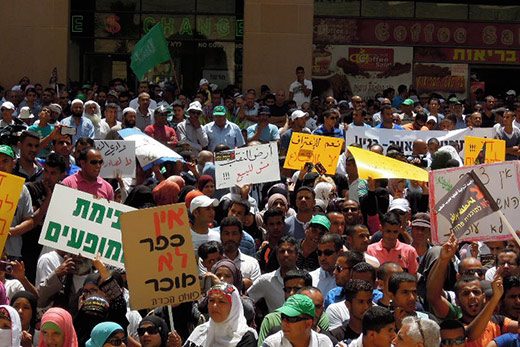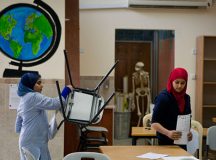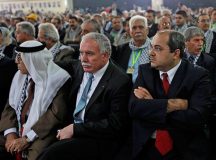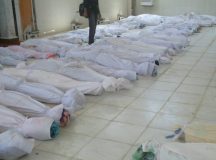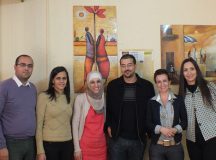An exciting new Bedouin Arab leadership is emerging in Israel’s Negev region. Younger, feminist, critical of both state policy and tribal culture, it is calling for a historic shift from victimhood to empowerment.
Identity rests on our answers to three questions: who are we, where did we come from, and where we are going? There are two contradictory ways – formal and informal – of telling the story of the Bedouin Arabs of Israel. The formal story depicts a nomadic society that does not belong in this place, having illegally invaded state lands, and which now needs to be regulated by the state from above, in planned settlements. Public opinion in Israel largely accepts this narrative and tends to view Bedouin Arab culture as primitive and violent, in need of a civilising process; a nomadic people, an immoral ‘other’ contrasted to the state’s moral project of redeeming the Negev.
The informal story of the Bedouin Arab society is based on oral history and cultural memory which narrates our belonging to the land throughout our long history. The land defines our values, shapes our behaviour as farmers and natives, and partly determines our social and economic status, the relations between the tribes, relations between men and women, and the internal communal hierarchies.
One of our main challenges as a Bedouin Arab society in Israel is to end our social exclusion and inferior status, to subvert our social representation as marginalised people living out miserable lives, and, crucially, to stop internalising that very representation as a self-image.
This challenge is being taken up by new leaders drawn from new social strata – a young, educated, professional and empowered generation, men and women from different tribes, engaged in social activism, and often inspired by feminism. This article explains why this new leadership emerged, its social location, and its political practice.
Historical background
Until 1948 there were 100,000 Bedouin Arabs living in their tribal lands in the Negev. After the war of 1948, 90 per cent were expelled or forced to escape to Gaza, Sinai, Jordan and the West Bank. The population fell to 10,000 and was transformed: once the owners of the land, we were now controlled by the new Israeli state. Today, there are approximately 170,000 Bedouin Arabs in the Negev, 60 per cent of whom are younger than 18.
A military regime was established between 1948 and 1966 as part of state policy toward its non-Jewish population and the Bedouin Arabs were mostly confined to the ‘Sayag,’ a restricted area under military rule located between Be’er Sheva, Arad and Yeroham. Some Bedouin Arabs now lacked a ‘tribal territory’, while some lived in the restricted area on their lands. And since land constituted the source of power and social status, two levels of status were created – those with land and those without land – this shaped the internal hierarchy of the tribes.
In 1967, with military rule abolished, Bedouin Arab towns were established at Rahat, Kseife, Arara, Shgeb alslam, Hura and Laqiya. All were urban in style, concentrating the Bedouin Arab into less territory, leading a ‘modern’ way of life. These towns did not suit the Bedouin way of life, suffered from a lack of physical infrastructure, high rates of unemployment, social tension and limited opportunities for social mobility and development: it is now widely accepted to have been a major policy error. Those Bedouin Arabs who did not move to the new towns often lived in ‘unrecognised villages’, which lacked infrastructure, schools, and clinics, and were periodically dismantled by the state.
Political and social trends
The new Bedouin Arab leadership in the Negev has emerged as a result of several social and political trends: a new relation between the Bedouin Arabs and the Palestinian Israelis in the north of Israel and the wider Israeli population, a growing number of Bedouin Arab men and women in higher education, the rise of a layer of activists and leaders within civic organisations that have a feminist agenda, and the development of Bedouin Arab civil society, including NGOs active in politics, education, women rights, health improvement, equality, and anti-racism. Finally, we have seen the development of Bedouin Arabs entering professional employment with their academic degrees and professional diplomas; there is a newly confident Bedouin Arab presence in education, social care, health, finance, and the legal profession. In short, the creation of Bedouin Arab middle class has, in turn, thrown up a new social and political leadership based largely on success in the worlds of education and employment rather than tribal and family background; it is young, educated, and willing to challenge the patriarchal hierarchy of Bedouin Arab society, transgressing gender and tribal boundaries.
This new Bedouin Arab political leadership is now active on four fronts, seeking to instil a new critical consciousness and a new identity in the Bedouin Arabs: empowered people not victims.
First, by developing a critical discourse that challenges both the dominant Israeli state discourse as well as those voices inside Bedouin Arab society who reject change. Bedouin Arab scholars are researching their history and mapping their identity in new ways and in their own voices, challenging the hitherto dominant narratives of Western, and especially Israeli scholars that have constructed the Bedouin Arabs as nomadic primitive tribes, with no connection to the land, and as a society without a history. This academic activism also contests the politically important level of epistemology: who produces knowledge, to whom is knowledge given, and how does knowledge shape the lives and the representations of the Bedouin Arab image in the public sphere?
Second, by capacity building: creating improvements with respect to health, education, welfare, equality, education, racism and physical infrastructure. For example, Bedouin Arab NGOs have developed an alternative plan for the recognition of the Bedouin Arab villages, based on their identity and cultural needs, working in collaboration with Jewish activists and with NGOs. In Sidrea and Laqiya, for example, women have developed locally sustainable economic projects – new fruits of a local feminism based on traditional values, working alongside the regional counsel for unrecognised villages in the Negev.
Third, by fighting for land rights and shaping the ongoing response to the government’s Prawer Plan. Resistance to the plan has been organised by two main forces: the patriarchal, traditional organisations and a new movement ‘Alhirak Alshababi’ led by younger, more liberal, women and men from the whole Palestinian society who are offering new methods, new agendas and new ways of thinking.
Fourth, by taking this new critical discourse, consciousness and practice into Bedouin Arab society as a challenge to the traditional elites and their hierarchal patriarchy based on land ownership. The new politics re-evaluates the meaning of solidarity and belonging, and reshapes the public sphere until it is a space to practice both; creating opportunities forindividual needs to be met as opposed to only those of the collective as defined by the elites. The imperative need is to develop a liberal space in the Negev in the face of some traditional and religious ways of thinking, and some old practices which have been internalised.
The new leadership in the Negev envisages nothing less than a revolution to strengthen Bedouin Arab society – a shift from a survival society to an active society, from victimhood to political assertion, and from patriarchy to a new hope for all Bedouin Arabs.

